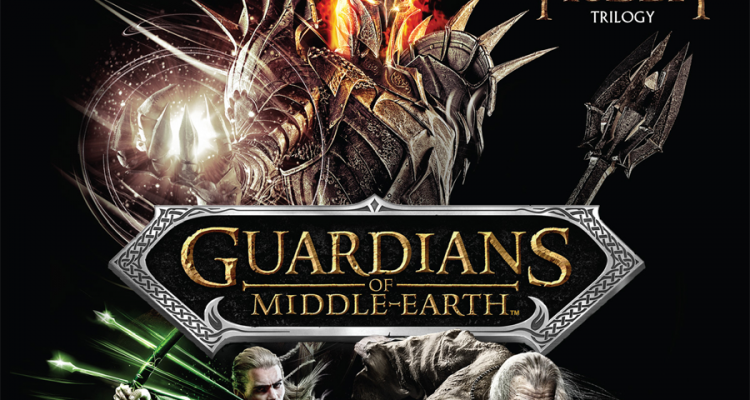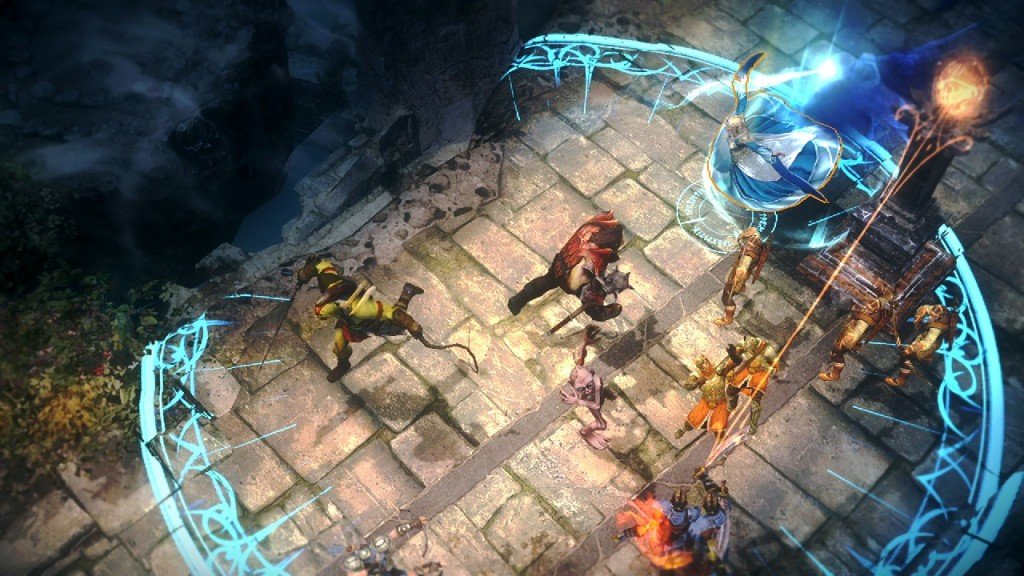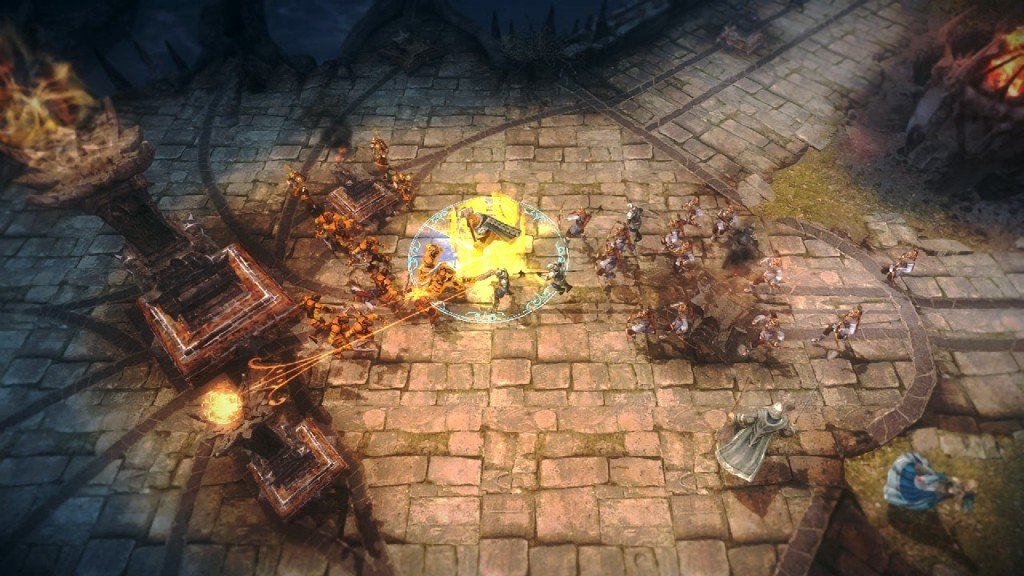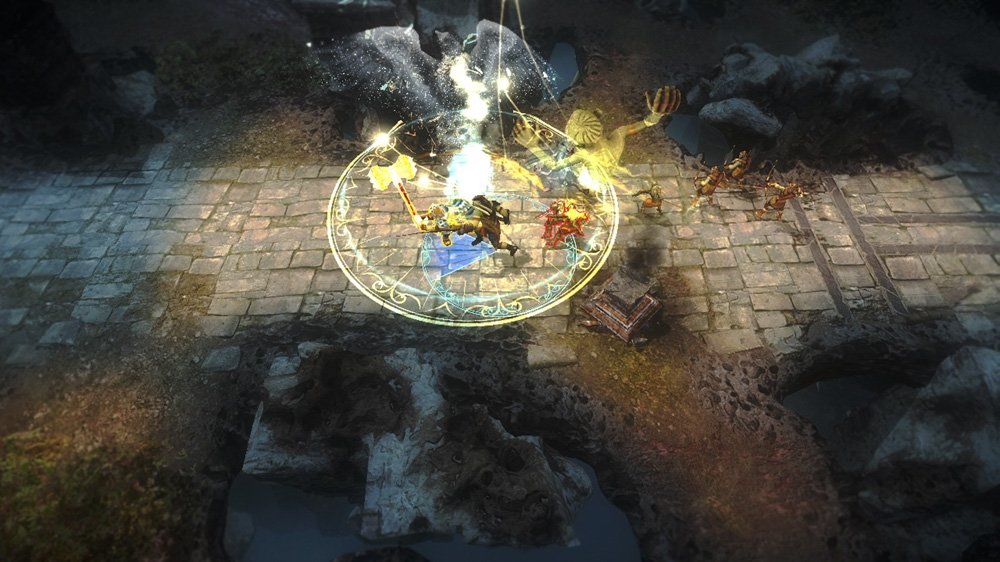The MOBA genre has exploded over the last few years, with titles such as Heroes of the Newerth, the original DotA, League of Legends, and Dota 2. Now Monolith and Warner Bros. have decided to enter the fray with Guardians of Middle-earth, a Lord of the Rings-themed MOBA game for Xbox 360 and Playstation 3. If you were ever afraid that a DotA-style game would be dumbed down if brought to a console, your fears were unfounded, as Guardians of Middle Earth is anything but dumb. In fact, it’s quite brilliant.
In Guardians of Middle Earth, you get the typical 3-lane, 6-tower map setup from a top-down perspective. The towers can be upgraded by players when they reach certain in-match levels. There are also neutral buff shrines in the jungle area between lanes that can be captured for your team. Each shrine increases your team’s health regeneration, allowing you to stay in lanes longer, which you need to do in order to gain XP. While there is a single-lane map, we’d advise against playing it, as it often devolves into cascading rage-quits that ruin the experience.
There are no item or gold mechanics in the individual matches, nor is there any last hitting required. These meta-game elements are relegated to Call of Duty-style load outs and unlocks from XP and gold gained by completing matches. The amount of individual load outs is gated by your account level. The items used within, however, are gated by gold. You purchase gems, potions, and relics from the in-game shop using gold, and this is basically a way of specializing your load outs to meet certain needs across a range of characters. This whole area of the game is way too large to cover extensively in a review. Suffice it to say, the depth and variety in load outs is immense.
The in-match skill mechanics have much more to do with teamwork and map awareness than twitch reflexes, though these can indeed come in handy. Movement is controlled with the left thumbstick. Attacks are controlled with the right thumbstick for directional aim, moving your character’s facing along a 360 degree axis. Your facing will also change with your movement, but holding the right stick will override the left stick’s facing controls, allowing you to strafe and backpedal reliably. A ring is drawn around your character, showing your attack range, area of attack (usually a cone), and directional facing. It works well most of the time, but there are situations where you can’t tell if you’re hitting your target or not.
Using abilities is frustrating. You get the same ring-like HUD element for each targeted skill, but these skills are assigned to the face buttons. We don’t know about you, but we don’t have the dexterity required to hit the A-button and use the right stick at the same time. You usually end up having to aim with your movement and just be careful enough not to run too far while attacking. It’s not ideal, but there is a certain level of learned skill in doing it right.
One nifty feature, seemingly borrowed from the original Monday Night Combat, is the ability to upgrade towers. Towers can be freely upgraded by all players as long as they are a certain in-match level, with each of the 4 upgrade types requiring a different minimum level in order to be applied. The creep waves can be altered in the same fashion by upgrading a barracks found behind each lane’s second tower. These barracks are immune to attack until the tower in front of them has been destroyed. Upgrading the barracks allows the creep wave to concentrate on different styles of pushing, such as heavy siege for breaking enemy towers, or improved front line fighters in order to hold the enemy from being able to push to your base easily. It’s a great strategic mechanic that more games in the genre could benefit from.
The Heroes – or in this case, Guardians – are ripped straight from the pages of Tolkien’s classic and range from the bastion of good himself, Gandalf the Grey, to the epitome of evil, Sauron, along with a few other notable characters like Gollum and Legolas. Each Guardian fits a different archetype and role, making for what could be an extremely diverse meta-game, although ultimately, only time and the community will decide how competitive the game becomes.
As for the community and player interaction, there doesn’t seem to be a lot going on in that department, at least within the game. Most players don’t seem to wear their headsets, which is a blessing and a curse at the same time. Time spent with the game has been rage- and troll-free, but just about every match has had someone disconnect or leave. It’s unfortunate, and we’ve yet to win a game shorthanded or lose a game with a numbers advantage. Luckily, queue times are short at about 2-3 minutes.
There really isn’t much else to say. The character design is great and borrows heavily from the films, and the sound is pretty top-notch, too. The graphics are as good as you’ll find on current-gen systems, if a bit muddied. But the gameplay is the core of the experience, and if you’re looking for an easy way to get into the genre, Guardians of Middle-earth is about the best bet you have. The barrier to entry is much less daunting, with fewer mechanics compared to other MOBAs, shorter matches, fewer characters, and fewer opportunities to be heckled. If you’re looking for an intensely deep MOBA experience, that’s still there as well, you just have to be willing to chase it.
Rating: 









This review is based on a retail copy of the Xbox 360 version of Guardians of Middle Earth developed by Monolith published by Warner Brothers




